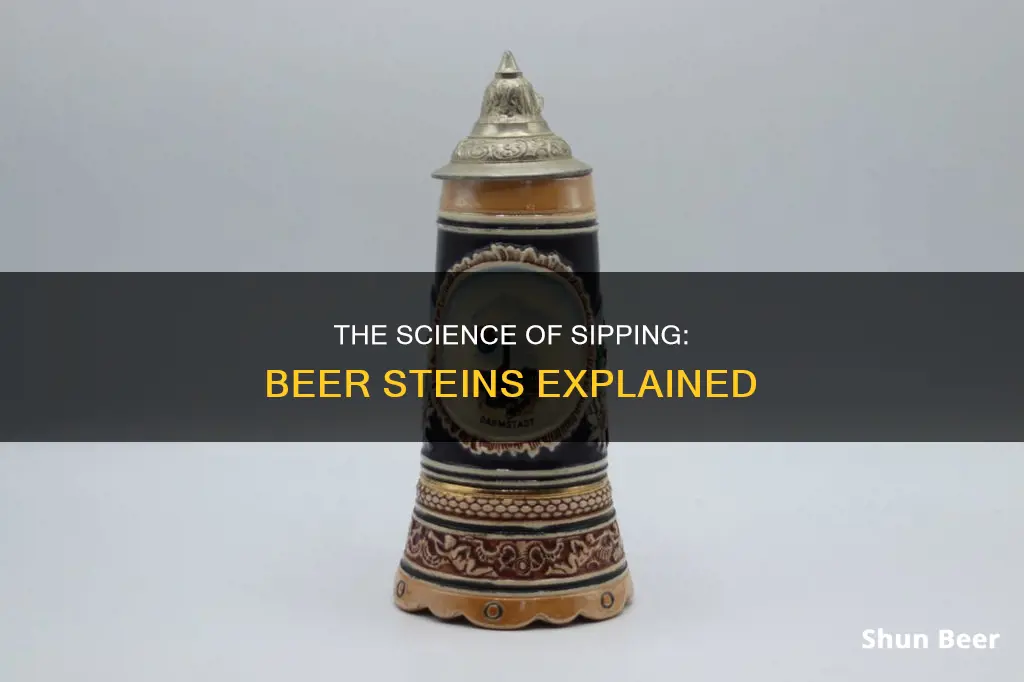
Beer steins, or simply steins, are traditional beer mugs that originated in Germany in the 14th century. They are typically made of stoneware, pewter, porcelain, silver, wood, crystal glass, or earthenware, and often feature intricate decorations, paintings, or coats of arms. The word stein is derived from the German word Stein Krug, meaning stone jug/mug, or Steingut, meaning stone goods. One of the unique features of beer steins is their hinged lid, which not only serves as a sanitary measure to keep insects and debris out of the beer but also helps to keep the drink cool for longer.
| Characteristics | Values |
|---|---|
| Origin | Germany |
| First appeared | 14th century |
| Purpose | To combat health issues during the Bubonic Plague |
| Materials | Stoneware, Pewter, Porcelain, Silver, Wood, Crystal Glass, Earthenware, Metal, Ceramic, Creamware |
| Lid | Hinged, with a thumb-lever |
| Lid material | Pewter |
| Lid types | Conical, Flat, Inlay, Ornamental, Stoneware |
| Volume | 0.03-32 litres |
| Common volume | 0.5 litres |
| Decoration | Hand-painted, glazed, engraved, enamel artwork, 3D artwork |
| Themes | Christmas, Wildlife, Military, Sports, Dogs, Game fish |
What You'll Learn

Beer steins originated in Germany in the 14th century
Beer steins, or simply "steins", originated in Germany in the 14th century. The bubonic plague and several invasions of flies in Europe led to the implementation of sanitation laws in Germany, requiring beverage containers to be covered. These laws, along with the development of stoneware, contributed to the creation of the stein. Stoneware, a type of earthenware created by raising the firing temperature of clay, allowed for the production of durable drinking vessels with attached lids.
The word "stein" is derived from German, with its etymology stemming from either "Stein Krug" (meaning stone jug/mug) or "Steingut" (meaning stone goods). Steins are typically made from materials such as stoneware, pewter, porcelain, silver, wood, or crystal glass. They feature a handle and a hinged lid, often decorated with engravings, paintings, or allusions to German culture.
Over time, steins became more than just drinking vessels. They evolved into status symbols and display pieces for German families, adorned with household crests, shields, or expressions. The unique designs and limited editions of steins made them desirable collectibles, with some steins being passed down through generations.
The largest producer of beer steins today is Ceramarte of Brazil, specialising in promotional products, mainly for Budweiser. However, the traditional area of beer stein production remains in the Kannenbäckerland region of Germany, where skilled craftsmen continue to create these iconic drinking vessels.
Miller Beer Text Rebates: How Do They Work?
You may want to see also

They were covered to prevent insects from entering
Beer steins were introduced in the 14th century as a result of the bubonic plague and several invasions of flies in Europe. Germany established laws requiring beverage containers to be covered for sanitary purposes. The hinged lids on beer steins were thus implemented to prevent insects from entering the beverage. While the belief that the Black Plague was spread by flies is now known to be untrue, the use of lids on beer steins remained a common practice.
The lids of beer steins are typically made of pewter and are equipped with a thumb-lever or thumblift, allowing the drinker to open and close the lid with one hand. These lids come in various shapes and sizes, from simple flat designs to elaborately decorated ones. Decorations may include handcrafted motifs, engravings, or pewter figures.
In addition to keeping insects out, the lids on beer steins also serve other purposes. They help to reduce heat exchange, keeping the beer cool for a longer period. The lids also act as a status symbol, with the material of the lid indicating the social class of the drinker. For waiters, the lid serves as a signal to know when a guest needs a refill.
The use of covered beer containers was not just a response to the plague and insect infestations but also reflected a broader concern for sanitation and health during that time. The development of stoneware, a non-porous and chip-resistant material, further enhanced the sanitary qualities of beer steins.
Understanding Beer Pumps: The Inner Workings Explained
You may want to see also

They were made from stoneware and pewter
Beer steins, or simply "steins", are drinking mugs that can be made of stoneware, a type of ceramic. The use of stoneware to make steins dates back to the 16th and 17th centuries, when stoneware beer mugs first became popular. The firing temperature of clay was raised, creating stoneware. This material allowed for the mass production of elaborately carved steins using moulds.
The word "stein" is derived from the German word for stone, and steins made from stoneware are often sought after by collectors for their authentic German feel. They are typically decorated with nostalgic allusions to Germany and may feature intricate hand-painted designs and detailed relief work.
Pewter, a tin-based alloy, was another common material used in the production of beer steins. It was the preferred material in many areas across Europe, especially England. The earliest known example of pewter-ware was found in Egypt and dated to 1350-1580 BC. In the 14th century, the formation of pewter trade guilds in London and Edinburgh led to the widespread use of pewter, and it experienced revivals in the 18th century and again in the 1970s.
Beer steins made from stoneware and pewter were often adorned with lids, typically made of pewter as well. The lids served a sanitary purpose, helping to keep insects out of the beverage. They were equipped with a thumb-lever, allowing the drinker to easily open and close the lid with one hand.
Tums to the Rescue: Beer Sickness Solution?
You may want to see also

They were decorated with paintings and coats of arms
Beer steins, which originated in the 14th century, are mugs used for drinking beer. They are made from a variety of materials, including earthenware, pewter, wood, ceramics, crystal, porcelain, creamware, silver, or glass. They are often decorated and sometimes hand-painted. The decorations on beer steins can vary, but they are commonly adorned with paintings and coats of arms.
German beer steins, in particular, often featured a household crest, shield, or expression. Each German family would have their own unique stein, which served as a status symbol and display piece. These steins were usually emblazoned with a family crest or shield, making them a source of pride and identity. Over time, the designs on these steins became more intricate and detailed, with artists using symbols and allusions to Germany to decorate them.
The paintings on beer steins can vary widely in subject matter and style. Some steins feature animals as the primary subject or include them in the background. For example, a beer stein might depict a cat, monkey, and herring—a combination that represents a hangover in German culture. Other animals and their symbolic meanings may be featured, such as a fox for cunning, a lion for courage and royalty, or a bear for strength.
In addition to animals, beer steins may also be decorated with coats of arms. These heraldic designs often include shields, crests, and other symbols associated with a particular family, region, or institution. Coats of arms on beer steins can signify nobility, heritage, or a sense of belonging. They may also be used to commemorate special occasions, such as birthdays, anniversaries, or weddings.
The combination of paintings and coats of arms on beer steins adds to their visual appeal and historical significance. These decorative elements not only make the steins more aesthetically pleasing but also transform them into storytelling vessels that reflect cultural eras and historical events.
Snail Solution: Beer Trap's Effectiveness and Efficiency
You may want to see also

They are now considered a symbol of Bavarian cosiness
Beer steins are drinking mugs, usually made from stoneware, pewter, porcelain, silver, wood, crystal glass, or earthenware. They are typically associated with Germany and have hinged pewter lids with a thumb-lever, allowing the drinker to open and close the lid with one hand.
The word "stein" is of German origin, derived from "Stein Krug" (stone jug/mug) or "Steingut" (stone goods). Beer steins originated in the 14th century, partly due to sanitation laws in Germany that required beverage containers to be covered to prevent insects from entering. Over time, they became a status symbol for German families, often decorated with a household crest, shield, or expression.
Today, beer steins are considered a symbol of Bavarian cosiness and culture. The use of beer mugs is uncommon in most parts of Northern and Central Germany and is considered a Bavarian specialty. The traditional area of beer stein production is the Kannenbäckerland in the Westerwald region of Germany, which has been creating beer steins for centuries.
The designs often include Bavarian motifs such as Neuschwanstein or the Marienplatz Rathaus-Glockenspiel of Munich, and the official annual Oktoberfest souvenir mug. Beer steins are also popular collectibles, with traditional designs such as brewery emblems and Bavarian motifs considered valuable.
The Bavarian state coat of arms, introduced on 5 June 1950, further emphasises the connection between beer steins and Bavarian culture. The coat of arms features various symbols with historical meanings, including the golden lion, the "Franconian rake," the blue panther, and the white and blue central shield, which is regarded as a symbol of Bavaria as a whole.
The combination of the traditional production techniques, the historical association with sanitation laws, and the iconic Bavarian motifs featured on beer steins has solidified their status as a symbol of Bavarian cosiness and hospitality.
Understanding Beer Extracts: The Science Behind the Brew
You may want to see also
Frequently asked questions
A beer stein is a drinking vessel used for beer, with a handle and a hinged lid, often decorated or hand-painted. They are made from materials such as earthenware, pewter, wood, ceramics, crystal, porcelain, creamware, silver, or glass.
Beer steins originated in the 14th century, during the time of the Bubonic Plague and fly invasions in Europe. As a result, Germany mandated that all drink containers must be covered for sanitary purposes. The lids also help keep the beer cool for longer.
Beer steins are typically made from earthenware, pewter, wood, ceramics, crystal, porcelain, creamware, silver, or glass.
The word "stein" is of German origin, derived from Stein Krug (meaning stone jug/mug) or Steingut (meaning stone goods).
There are several types of beer stein lids, including conical lids, flat lids, inlay lids, ornamental lids, and stoneware lids. Conical lids are the least expensive, while ornamental lids are the most popular for limited-edition steins.







